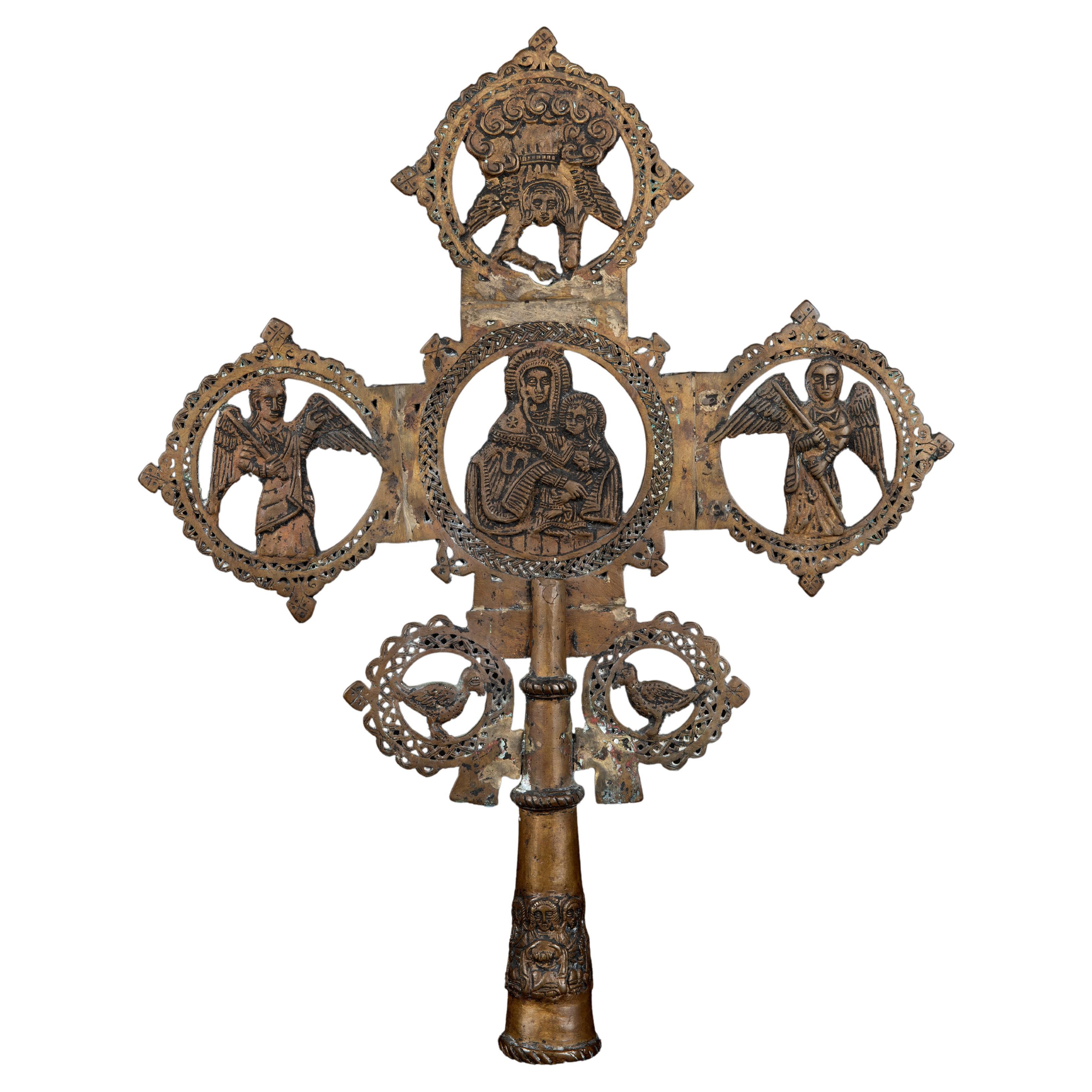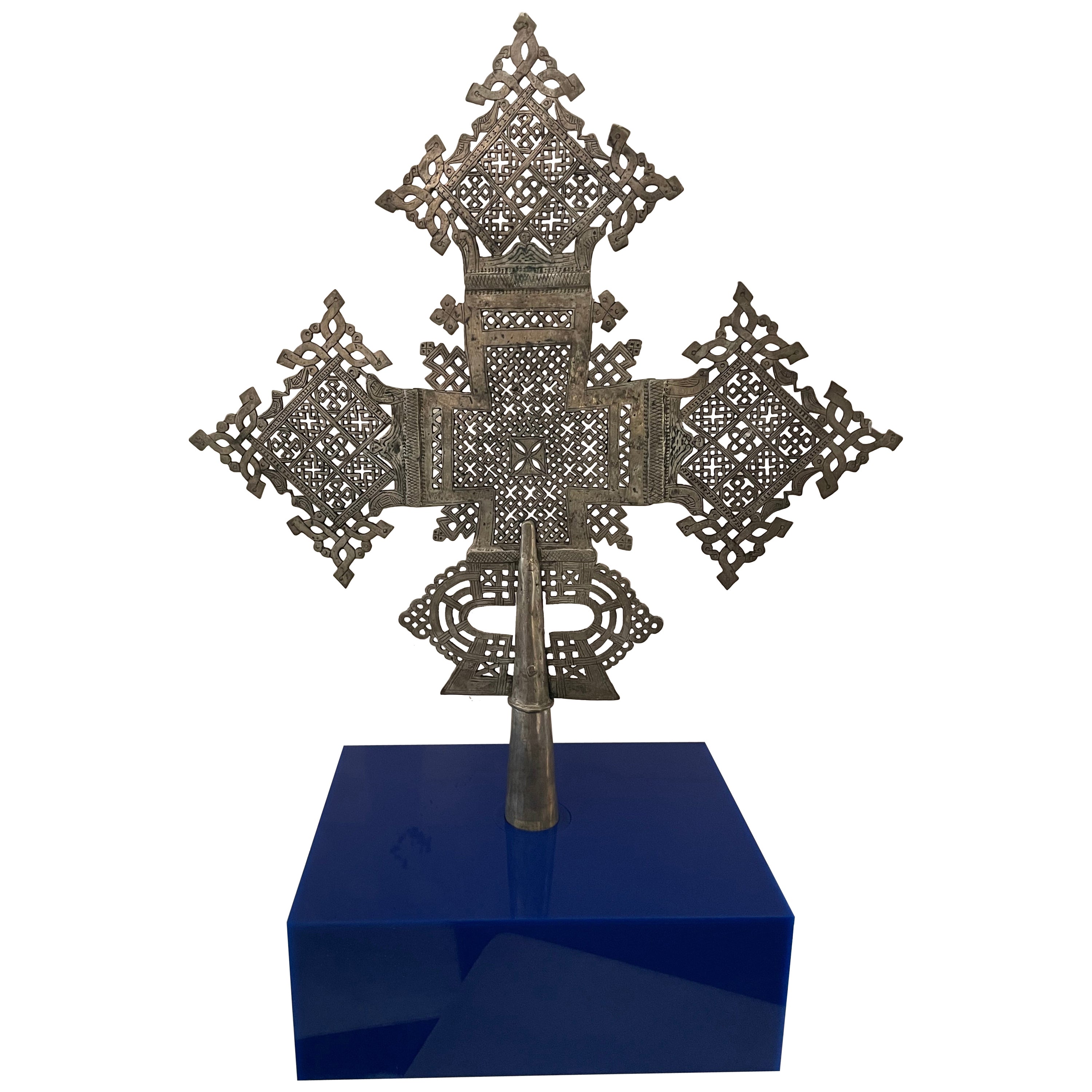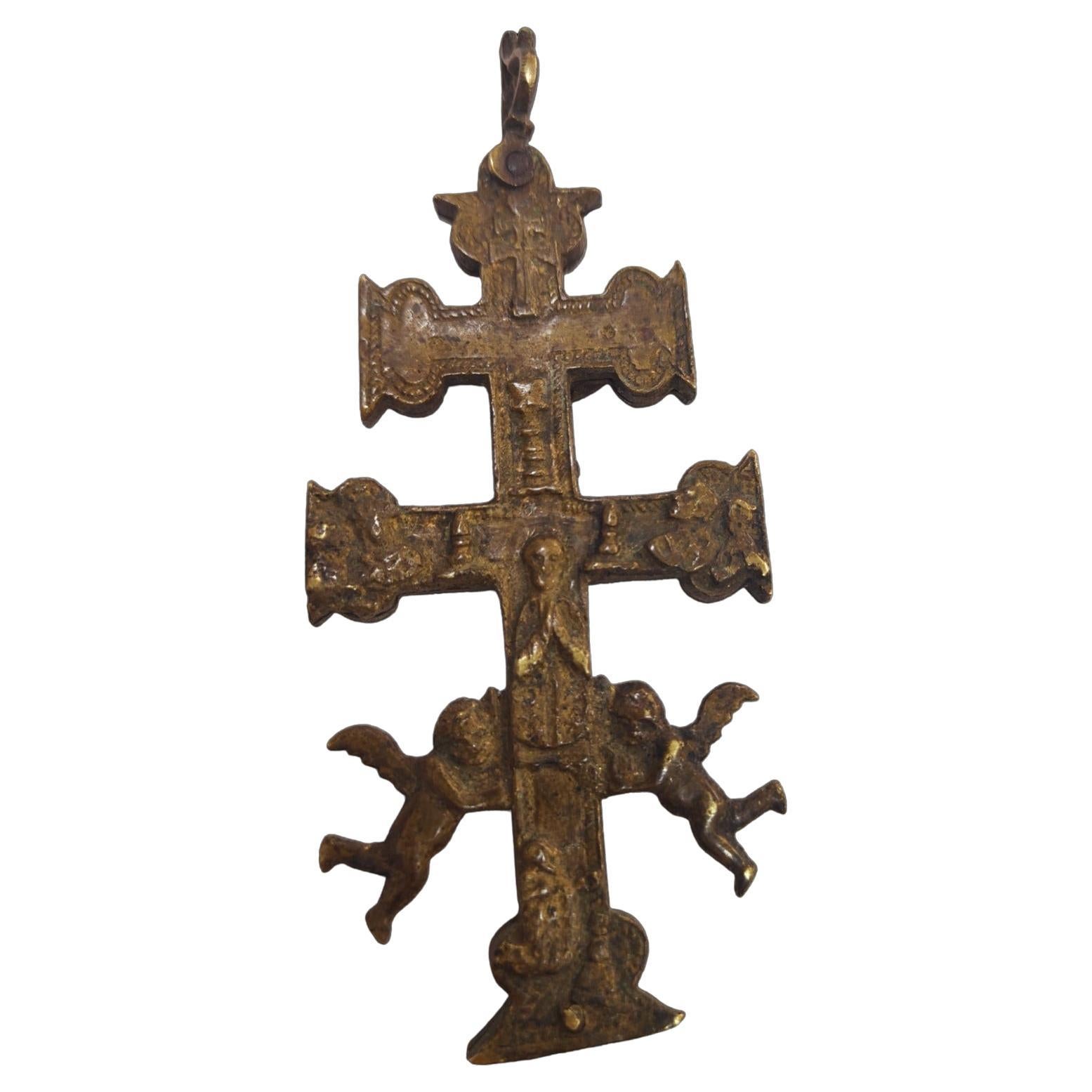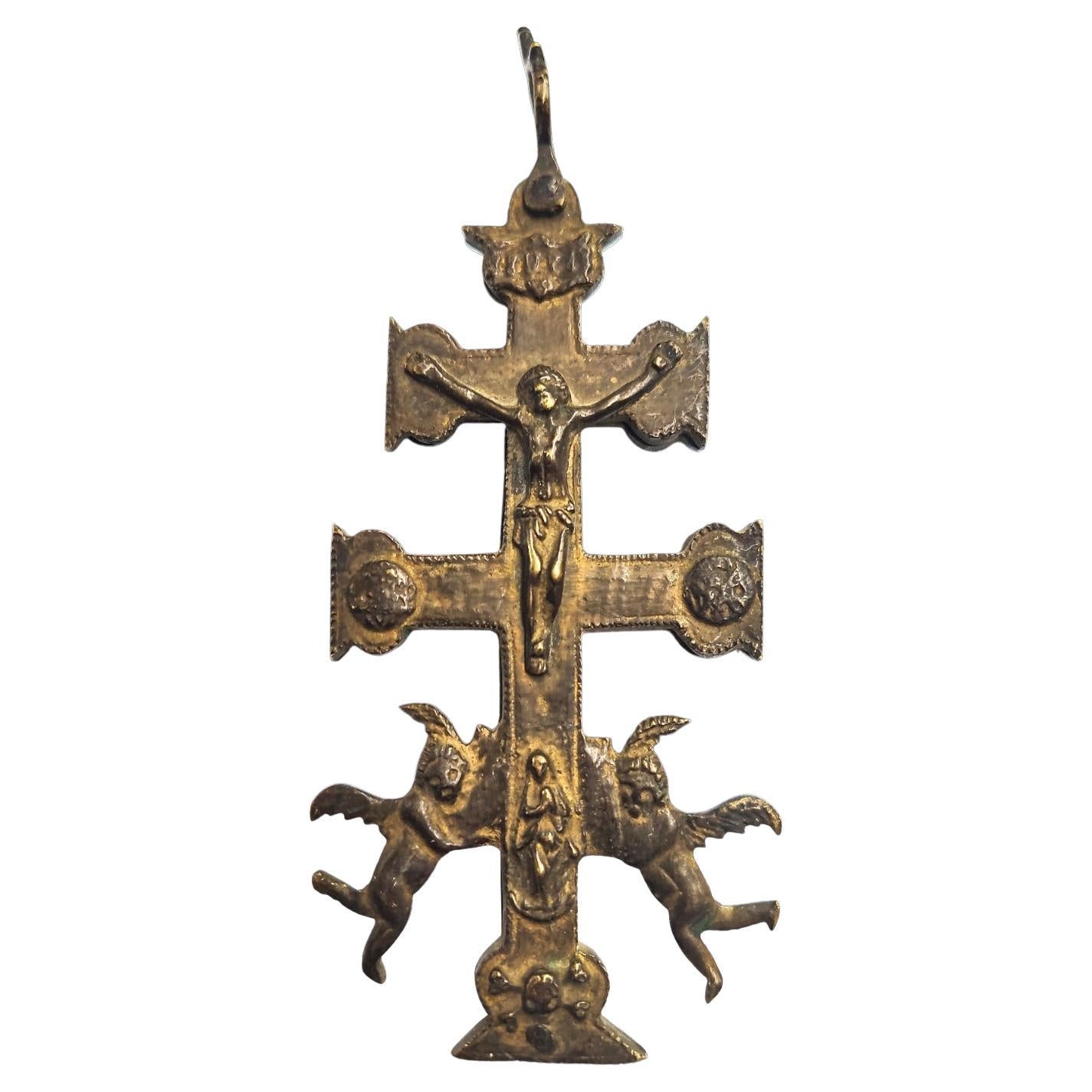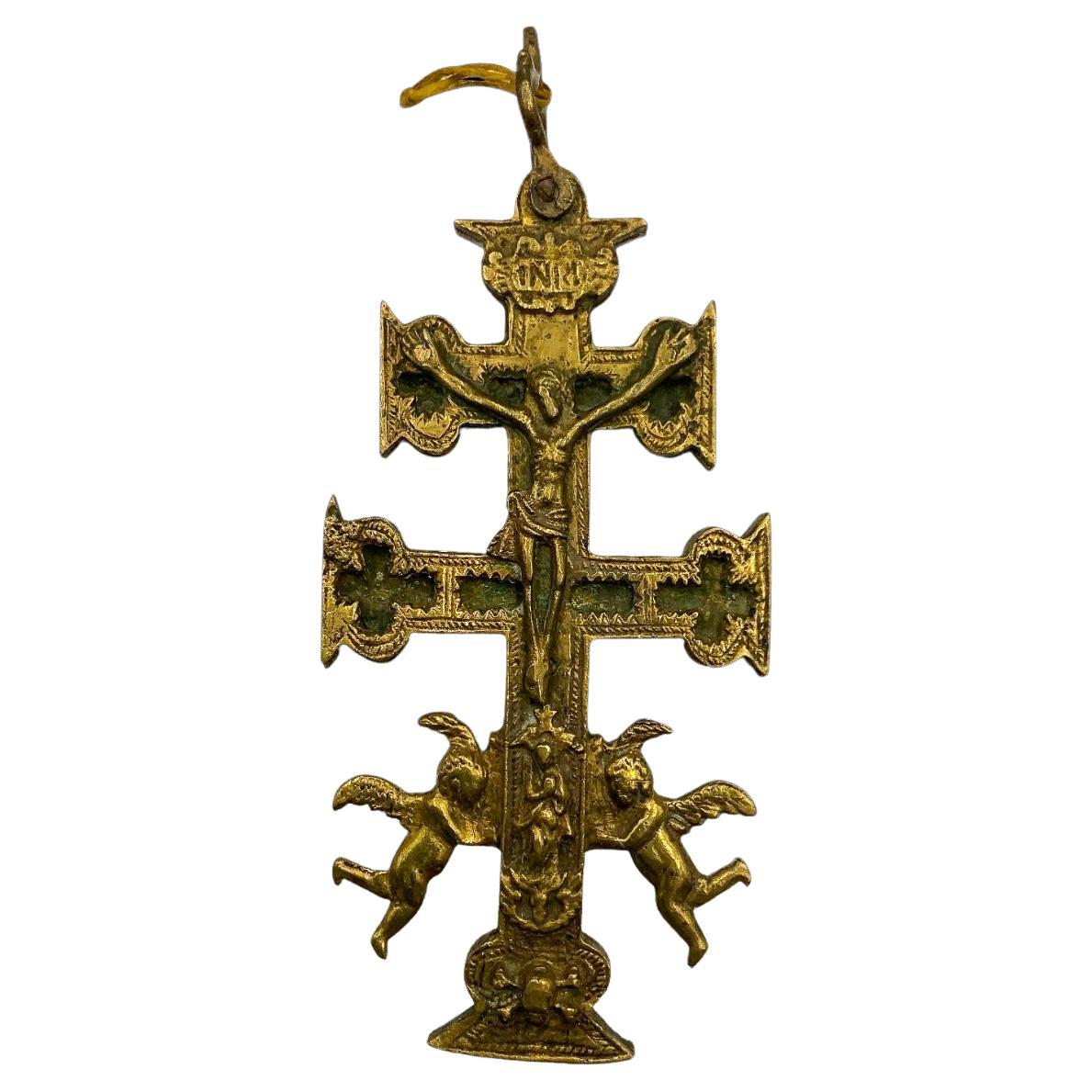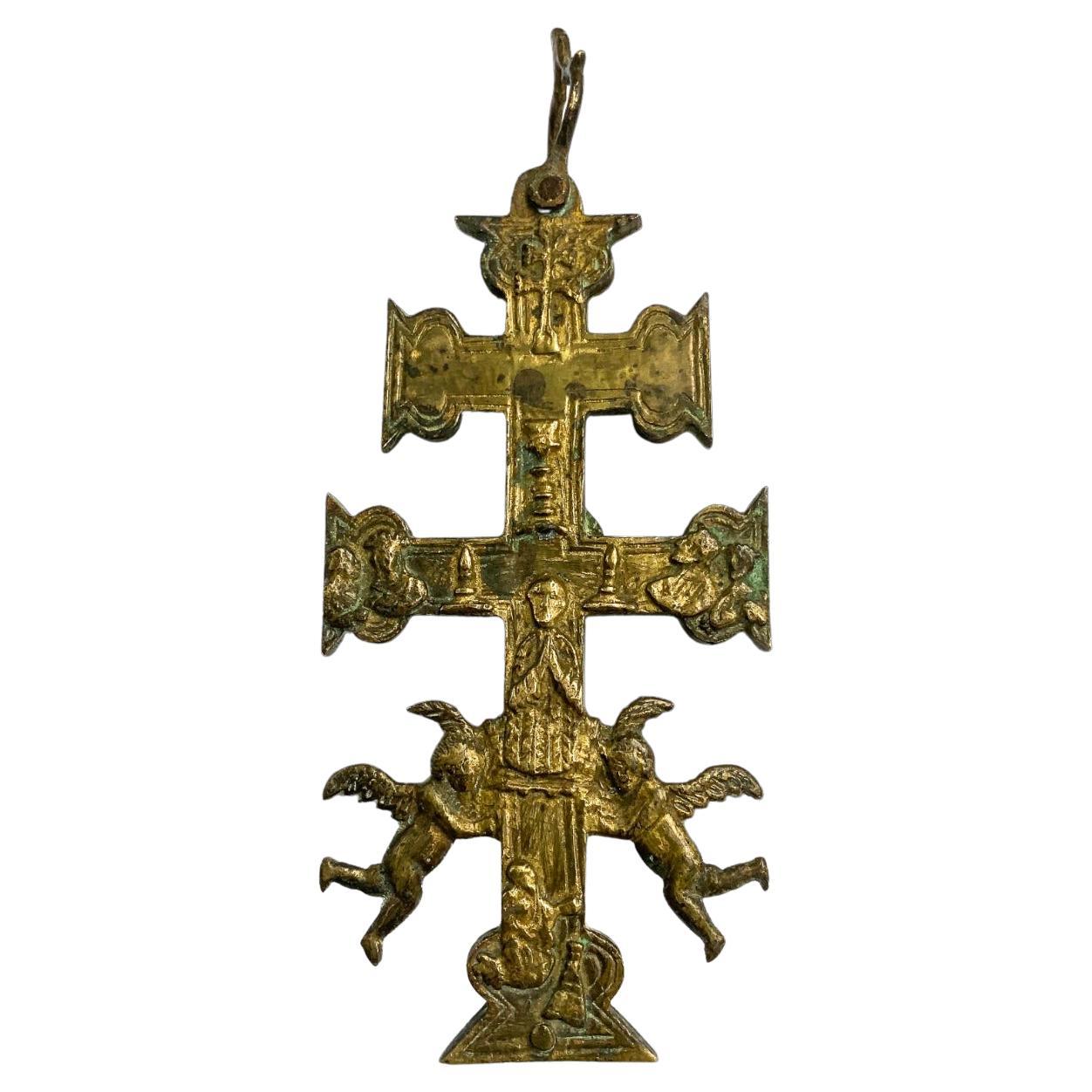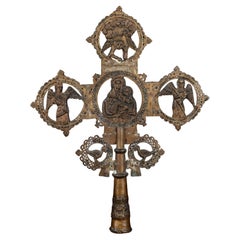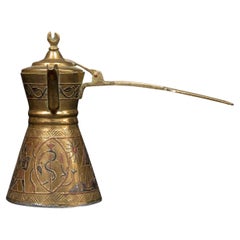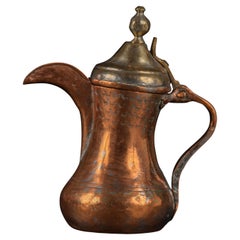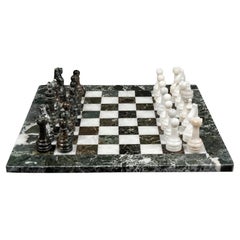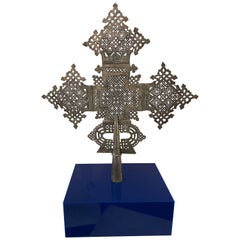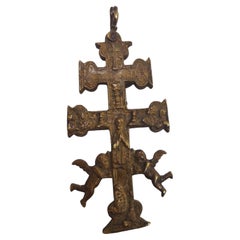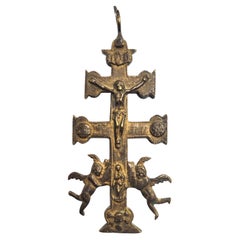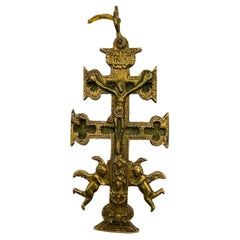Items Similar to The Ethiopian Procession Cross: A Radiant Symbol of Faith, Guardian of Sacred
Want more images or videos?
Request additional images or videos from the seller
1 of 12
The Ethiopian Procession Cross: A Radiant Symbol of Faith, Guardian of Sacred
$6,176.92
£4,650.28
€5,230
CA$8,509.12
A$9,529.68
CHF 4,972.43
MX$116,400.89
NOK 63,263.76
SEK 59,633.67
DKK 39,811.47
About the Item
The Ethiopian Procession Cross: A Radiant Symbol of Faith, Guardian of Sacred Mysteries.
Artistic and Historical Description This Ethiopian procession cross, of rare beauty, embodies a long tradition of Christian religious art in Ethiopia, a country where the Tewahedo Orthodox Church has played a central role for centuries. Crafted from a metal alloy, likely brass or silver, this cross features meticulously chiseled sculptural elements, testifying to an ancestral know-how passed down through generations by Ethiopian artisans. Procession crosses like this one are carried at the head of religious processions during feasts and liturgical ceremonies, symbolizing faith and divine blessing. They are often richly decorated and adorned with elaborate motifs that tell biblical stories, sacred histories, and prayers engraved in the metal.
Iconographic Analysis The cross you have shared features a complex and rich iconography.
- Here is an overview of the main figures and their roles in the Ethiopian religious context:
• Christ Pantocrator: Typically placed at the center or on the upper part of the cross, Christ Pantocrator (King of the Universe) is depicted blessing with his right hand raised and holding the Gospel in his left. This image is central to Orthodox Christian iconography and symbolizes the sovereignty and mercy of Jesus Christ over the world.
• The Virgin Mary and the Child Jesus: At the center of the cross, one often finds a depiction of the Virgin Mary holding the Child Jesus. This motif, called "Theotokos" (Mother of God), symbolizes divine motherhood and the incarnation of Christ. Mary is venerated as the protector of the Church and is often surrounded by angels, indicating her holiness and special place in Orthodox Christianity.
• Angels: Depictions of angels on the arms of the cross, sometimes with spread wings, symbolize divine messengers and celestial protectors. They are often depicted holding instruments of Christ's passion, such as the lance or the sponge, thus emphasizing their role in the events of the Crucifixion and their mission to praise and serve God.
• Prophets and Saints: On the lower or lateral parts, it is common to find images of Old Testament prophets, local saints, or apostolic figures. Each figure is accompanied by specific iconographic details (books, instruments of martyrdom, etc.) that help identify their role and importance in the Christian tradition.
- Symbolism and Spiritual Significance Every detail of this procession cross tells a sacred story and reminds the faithful of the foundations of their faith. The geometric and floral motifs that adorn the cross symbolize eternal life, Christ's victory over death, and the promise of salvation for all believers. The circle, often seen around the figures, is a symbol of eternity and infinity, indicating the timeless and universal nature of God.
Liturgical Role and Usage Procession crosses play a central role in the rituals of the Ethiopian Orthodox Church. They are carried by priests or deacons during processions, accompanied by liturgical chants, incense, and prayers. The processions themselves are public manifestations of faith, serving to bless the participants, communities, and surrounding lands.
- Conclusion This Ethiopian procession cross is not merely an object of religious art, but a powerful symbol of faith and Christian history in Ethiopia. Each engraved element and each depicted figure tells a part of this story, rooted in centuries of devotion, prayer, and religious practice. It is a living t
- Dimensions:Height: 44 in (111.76 cm)Width: 34 in (86.36 cm)Depth: 2 in (5.08 cm)
- Style:Primitive (Of the Period)
- Materials and Techniques:
- Place of Origin:
- Period:
- Date of Manufacture:Inconnu
- Condition:Wear consistent with age and use.
- Seller Location:Ixelles, BE
- Reference Number:1stDibs: LU10116242369702
About the Seller
No Reviews Yet
Vetted Professional Seller
Every seller passes strict standards for authenticity and reliability
1stDibs seller since 2024
- ShippingRetrieving quote...Shipping from: Ixelles, Belgium
- Return Policy
Authenticity Guarantee
In the unlikely event there’s an issue with an item’s authenticity, contact us within 1 year for a full refund. DetailsMoney-Back Guarantee
If your item is not as described, is damaged in transit, or does not arrive, contact us within 7 days for a full refund. Details24-Hour Cancellation
You have a 24-hour grace period in which to reconsider your purchase, with no questions asked.Vetted Professional Sellers
Our world-class sellers must adhere to strict standards for service and quality, maintaining the integrity of our listings.Price-Match Guarantee
If you find that a seller listed the same item for a lower price elsewhere, we’ll match it.Trusted Global Delivery
Our best-in-class carrier network provides specialized shipping options worldwide, including custom delivery.More From This Seller
View AllEthiopian Procession Cross: A Sacred Heritage and Craftsmanship
Located in Ixelles, BE
Ethiopian Procession Cross: A Sacred Heritage and Craftsmanship.
Structure and Composition: This finely crafted Ethiopian procession cross is rich in iconographic detail. Constructed from metal, likely bronze or brass, it features a complex structure with several decorative elements.
- Central Part:
• Madonna and Child: At the heart of the cross is a depiction of the Virgin Mary holding the Child Jesus. This central image is framed within a circle adorned with openwork motifs and small inlays that appear to be precious stones or colored glass pieces.
Arms of the Cross:
• Angelic Musicians: Each lateral arm of the cross features an angelic musician, playing instruments and depicted in a flying position. The angels are finely detailed, with spread wings and carefully sculpted garments.
• Cherub: At the apex of the cross, a cherub is depicted, a celestial being with multiple wings and surrounded by cloud-like motifs.
• Bird Motifs: The lower extremities of the cross are adorned with bird motifs, likely doves, symbolizing peace and the Holy Spirit, placed within openwork circles.
Base and Handle:
• Engraved Base: The base of the cross, which serves as a handle, is also richly engraved with floral and geometric motifs, providing a sturdy and decorative grip for processions.
History of Ethiopian Procession Crosses
Origins and Evolution: Ethiopian procession crosses have a long history, dating back to the introduction of Christianity to Ethiopia in the 4th century under King Ezana. Influenced by Coptic and Byzantine traditions, these crosses evolved to adopt a distinctive style unique to Ethiopia.
- Characteristics:
• Style and Iconography: Ethiopian crosses...
Category
Antique 19th Century Ethiopian Primitive Tribal Art
Materials
Brass
Egyptian Dallah Coffee Pot: A Symbol of Hospitality and Cultural Richness
Located in Ixelles, BE
Egyptian Dallah Coffee Pot: A Symbol of Hospitality and Cultural Richness.
- Object:
A dallah (Arabic: دلة) is a traditional Arab coffee pot used to prepare and serve coffee in the...
Category
20th Century Egyptian Egyptian Serving Pieces
Materials
Brass
Dallah Coffee Pot: A Masterpiece of Arab Hospitality and Art
Located in Ixelles, BE
Dallah Coffee Pot: A Masterpiece of Arab Hospitality and Art
The "Dallah" coffee pot we see here is a magnificent piece representative of Arab culture. Likely made of copper, it fea...
Category
Early 20th Century Unknown Islamic Serving Pieces
Materials
Copper
Marble Masterpiece: For Connoisseurs of Refinement
Located in Ixelles, BE
Marble Masterpiece: For Connoisseurs of Refinement.
Dive into the exclusivity of chess with our black zebra marble and white set, a stunning fusion of luxury and contemporary design...
Category
Early 20th Century Pakistani Mid-Century Modern Figurative Sculptures
Materials
Marble
GUSTAVE VAERENBERGH (1873-1927) Bust in Alabaster and Gilt Bronze "JEANNE D'ARC"
By Gustave van Vaerenbergh
Located in Ixelles, BE
GUSTAVE VAERENBERGH (1873-1927) Bust in Alabaster and Gilt Bronze "JEANNE D'ARC" (end 19th century-early 20th century)
- THE WORK:
The alabaster and gilt bronze bust of Joan of A...
Category
Antique Late 19th Century French Art Nouveau Busts
Materials
Alabaster, Bronze
Small square malachite and marble chessboard
Located in Ixelles, BE
Small square malachite and marble chessboard.
Dive into absolute opulence with our malachite and marble chess set, an undisputed symbol of luxury and refinement.
Each piece, meticu...
Category
20th Century Kenyan Mid-Century Modern Figurative Sculptures
Materials
Malachite, Marble
You May Also Like
Ethiopian Coptic Processional Cross
Located in Los Angeles, CA
Very unique Ethiopian processional cross, brass, early 20th century. Base is covered in Yves Klein Blue lucite measuring 12.5" D x 16.5" W x 6" H
Provenance: Collection of Lillian Florsheim...
Category
Early 20th Century Abstract Sculptures
Materials
Brass
$3,840 Sale Price
20% Off
Cross of Caravaca 17th Century
Located in Madrid, ES
Cross of caravaca XVII century.
Very beautiful cross of caravaca made in bronze. 17th Century. Measurements: 14X6 cm.
Good condition.
Category
Antique 17th Century Italian Gothic Religious Items
Materials
Bronze
CROSS OF CARAVACA 17th CENTURY
Located in Madrid, ES
CROSS OF CARAVACA XVII CENTURY
BEAUTIFUL CARAVACA CROSS FROM THE 17TH CENTURY IN BRONZE. MEASURES: 12.5X5.5 CM. IN GOOD CONDITION
good condition
Category
Antique 17th Century Italian Gothic Religious Items
Materials
Bronze
Cross of Caravaca 17th Century
Located in Madrid, ES
Cross of caravaca XVII century.
Very beautiful cross of caravaca made in bronze. 17th Century. Measurements: 15x6 cm.
Good condition.
Category
Antique 17th Century Italian Gothic Religious Items
Materials
Bronze
Cross of Caravaca 17th Century
Located in Madrid, ES
Cross of caravaca XVII century.
Very beautiful cross of caravaca made in bronze. 17th Century. Measurements: 15x6 cm.
Good condition.
Category
Antique 17th Century Italian Gothic Religious Items
Materials
Bronze
19th Century Orthodox Cross
Located in Madrid, ES
This magnificent 19th-century Orthodox cross is crafted in bronze, a material that ensures its durability and beauty over time. The dimensions of the cross are 17 cm in height, 10 cm...
Category
Antique Late 19th Century Religious Items
Materials
Bronze
